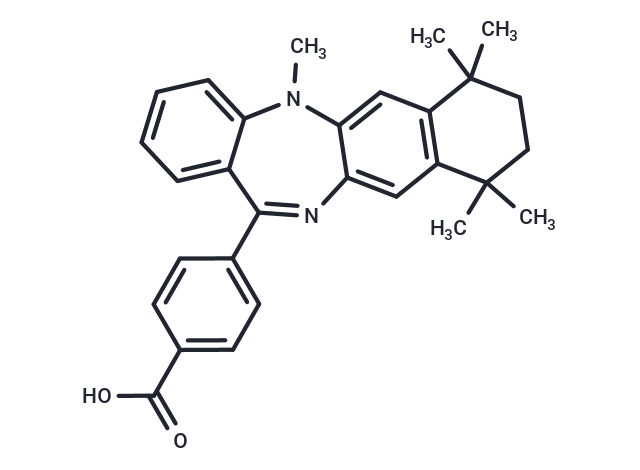Shopping Cart
- Remove All
 Your shopping cart is currently empty
Your shopping cart is currently empty

LE135 is a potent RAR antagonist that binds selectively to RARα (Ki of 1.4 μM) and RARβ (Ki of 220 nM), showing higher affinity for RARβ. It is highly selective over RARγ, RXRα, RXRβ, and RXRγ. LE135 also acts as a potent TRPV1 and TRPA1 receptor activator with EC50s of 2.5 μM and 20 μM, respectively.

| Pack Size | Price | Availability | Quantity |
|---|---|---|---|
| 1 mg | $39 | In Stock | |
| 2 mg | $56 | In Stock | |
| 5 mg | $93 | In Stock | |
| 10 mg | $137 | In Stock | |
| 25 mg | $229 | In Stock | |
| 50 mg | $342 | In Stock | |
| 100 mg | $497 | In Stock | |
| 1 mL x 10 mM (in DMSO) | $98 | In Stock |
| Description | LE135 is a potent RAR antagonist that binds selectively to RARα (Ki of 1.4 μM) and RARβ (Ki of 220 nM), showing higher affinity for RARβ. It is highly selective over RARγ, RXRα, RXRβ, and RXRγ. LE135 also acts as a potent TRPV1 and TRPA1 receptor activator with EC50s of 2.5 μM and 20 μM, respectively. |
| Targets&IC50 | RARβ:220 nM (Ki), TRPV1:2.5 μM (EC50), TRPA1:20 μM (EC50), RARα:1400 nM (Ki) |
| In vitro | LE135 blocks the differentiation of human promyelocytic leukemia cells HL-60, triggered by Am80, with an inhibitory concentration (IC50) of 150 nM. It specifically hinders retinoic acid (RA)-prompted transcriptional activation of the retinoic acid receptor beta (RARβ) without affecting RARα, RARγ, or the retinoid X receptor alpha (RXRα) across various RA response elements. Furthermore, LE135 significantly suppresses the activity of the AP-1 transcription factor induced by 12-O-tetradecanoylphorbol-13-acetate in cells that express RARβ and RXRα. |
| In vivo | LE135 induces nociceptive responses and thermal hyperalgesia primarily via TRPV1 channels, and necessitates both TRPA1 and TRPV1 channels to cause mechanical allodynia. Intraplantar injection of LE135 (30 nmol/10 μL) results in mechanical hypersensitivity in both wild-type and Trpa1−/− mice[2]. |
| Alias | LE 135 |
| Molecular Weight | 438.56 |
| Formula | C29H30N2O2 |
| Cas No. | 155877-83-1 |
| Smiles | CN1c2cc3c(cc2N=C(c2ccc(cc2)C(O)=O)c2ccccc12)C(C)(C)CCC3(C)C |
| Relative Density. | 1.17 g/cm3 (Predicted) |
| Storage | Powder: -20°C for 3 years | In solvent: -80°C for 1 year | Shipping with blue ice. | |||||||||||||||||||||||||||||||||||
| Solubility Information | DMSO: 45 mg/mL (102.6 mM), Sonication is recommended. | |||||||||||||||||||||||||||||||||||
Solution Preparation Table | ||||||||||||||||||||||||||||||||||||
DMSO
| ||||||||||||||||||||||||||||||||||||

Copyright © 2015-2024 TargetMol Chemicals Inc. All Rights Reserved.